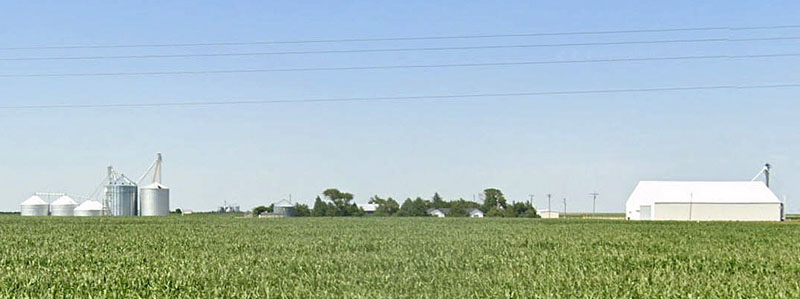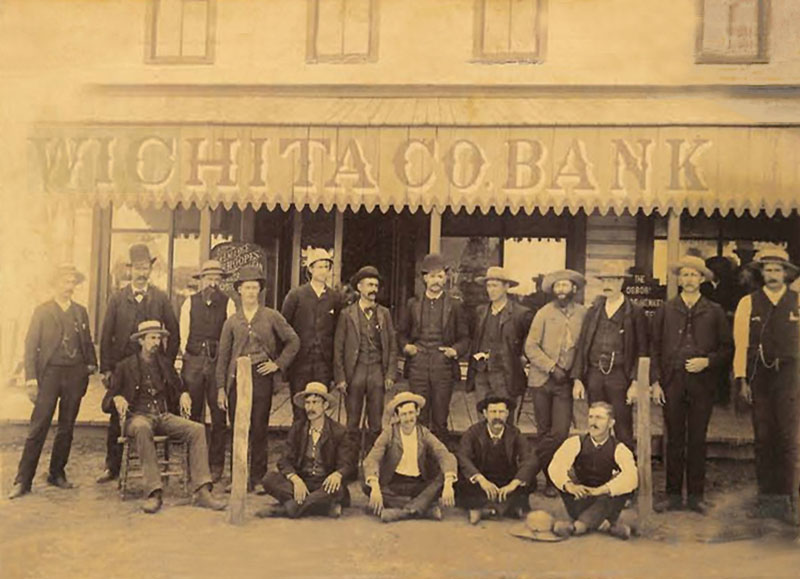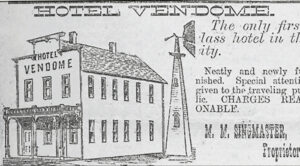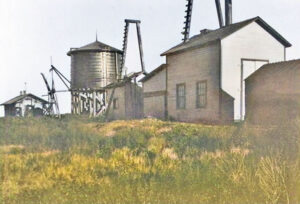
The old townsite of Coronado, Kansas, in Wichita County, courtesy of Google Maps.
Coronado, Kansas, is a mostly abandoned place in Wichita County. It is located three miles east of Leoti.
Coronado began when John Knapp and W.D. Brainerd wanted to establish a town that would rival Leoti, which everyone in the county assumed would be the county seat. The town was platted in 1885.
Within no time, Coronado became quite a little competing village, with several stores and saloons opening up one after another. Knapp and Brainerd’s reasoning behind the name was presumably due to the Spanish explorer Francisco Vasquez de Coronado, who explored much of western Kansas. When Coronado encountered Wichita Indians, he pronounced their name as the “Escansaques.”
Within three months of establishing Coronado, residents had constructed the Hotel Vendome.
In 1886, the newly formed town of Coronado was abuzz with excitement as news of the railroad’s arrival in Western Kansas spread. On January 28, 1886, the first edition of the Coronado Star went to the press. The post office was established on February 10, 1886.
By the spring of 1886, Coronado began to appear as a threat to Leoti for who would win the county seat. In under a year, Coronado had transformed from a desolate area to a thriving town, boasting two hotels, two banks, hardware stores, a post office, and a bakery. Both towns had been established in 1885, but since Leoti had been founded first in the entire soon-to-be-county, and being geographically centered in the county, people from the surrounding area felt that Leoti should be the county seat. Coronado and Leoti were twin towns; Leoti had just barely beaten Coronado to the first land claim for a town.
That year, the news broke that two railroads were actually coming. Before long, a depot, machine shops, a pump house, a well, and a water tank were all in place. The Coronado station was to be a division point. New businesses were springing up fast. Soon, the little country town had two hotels, a bank, several real estate and loan offices, a dry goods store, several hardware stores, a livery stable, two stage lines, a millinery shop, contractors and builders, and soon another newspaper, called the Coronado Herald, started business. More new businesses were arriving almost daily. Coronado was on the “Boom.”
By the summer of 1886, Coronado was at a steady growing pace with the neighboring town of Leoti. As both towns began to attract more people, one of them had to be the county seat.
Soon, Coronado would find itself involved in one of the bloodiest county seat fights in the history of the American West. During its fight with Leoti, a shoot-out occurred on February 27, 1887, when men from nearby Leoti left several people dead and wounded. That unsettled period drew many outsiders to the county, with Leoti attracting “toughs” from Wallace County and Coronado drawing lawmen and gunfighters from the Dodge City area. Luke Short, Wyatt Earp, Doc Holliday, Bat Masterson, Bill Tilghman, and others posed for the photograph that was taken in front of the Wichita County Bank in Coronado sometime that spring. Even though they were not involved in the actual gunfight, they were in Wichita County to intimidate at the voting polls.

Dodge City men posing in front of Wichita County Bank, in Coronado, Kansas.
Competition between these towns was fierce, not just among the peers in the streets, but it had grown into the newspapers. Editors of the newspapers would constantly accuse each other of lying, blasphemy, and even murder!
Another small town, Farmer City, located between Coronado and Leoti, was hoped by some to become the county seat, which would end the fighting.
By March of 1887, Coronado had a total of 100 stores that had come and gone. Compared to its neighbor, Leoti, Coronado was said to be smaller but more advanced in architectural design, offering finer and larger homes to its residents.
On March 10, 1887, Leoti won the right to become the county seat.
On July 28, 1887, the first steam locomotive arrived at Coronado. The Missouri Pacific Railroad was the first to finish its line. About a month later, the Chicago, Kansas & Western Railroad pulled in with their locomotive. People would board the train and ride over to the next county, into Scott City, to go to an afternoon baseball game. Riding the train became a social event.
The railroads continued their race on to Leoti, which was to be a stopping place to pick up passengers and freight at the depots. As they made it to each town, the Leoti Standard newspaper reported, “there was great jolification and celebration.”
Next on the line was the little town of Selkirk, about ten miles west of Leoti and one and one-fourth miles east of the Wichita/Greeley County line. Again, the Chicago, Kansas & Western Railroad arrived in the town first, but the Atchison, Topeka & Santa Fe Railroad was close behind. The Selkirk Graphic newspaper of the late 1800s has provided us with many details about the events surrounding the railroad in this small town. It too was expanding as news was learned that the railroad was going through town.
The track was completed on September 15, 1887, and the first regular train was run through to Selkirk on January 1, 1888. There was a large freight yard; the capacity at this point was not exceeded by any station on the line between here and Rush Center. It had a switch room for 12 cars more than at any point on the line. Selkirk had a capacity of 71, while the next was Modoc with 49, and Leoti and Grigsby had a capacity of 58.
The Atchison, Topeka & Santa Fe Railroad had built a large depot with a ticket office, a telegraph office, an ample waiting room, a freight house, machine shops, seven acres of stockyards with double-loading chutes, a large wooden water tower, a pump house, and a hand-dug well.
In the meantime, Leoti town planners had been offering to purchase buildings from Coronado and relocate them to Leoti. Businessmen also offered Coronado residents free lots within the city limits of Leoti. Soon, Coronado began to fade away.
Coronado’s post office closed on September 15, 1899. Afterward, its mail was received by rural free delivery from Leoti
In 1910, Coronado was still a station on the Missouri Pacific Railroad.
Coronado was three miles east of Leoti. The old townsite is now a farmstead, featuring several silos, a row of trees, a few buildings, and a large shed.
©Kathy Alexander/Legends of Kansas, October 2025.
Also See:
Extinct Towns of Wichita County
Sources:
Blackmar, Frank W.; Kansas: A Cyclopedia of State History, Vol I; Standard Publishing Company, Chicago, IL 1912.
Harkness, Steve; The Great County Seat War: Coronado vs. Leoti Wichita County, Kansas 1885-1887, Chapman Center for Rural Studies, Spring, 2013.
Kansas Post Office History
Wichita County Museum
Wikipedia


